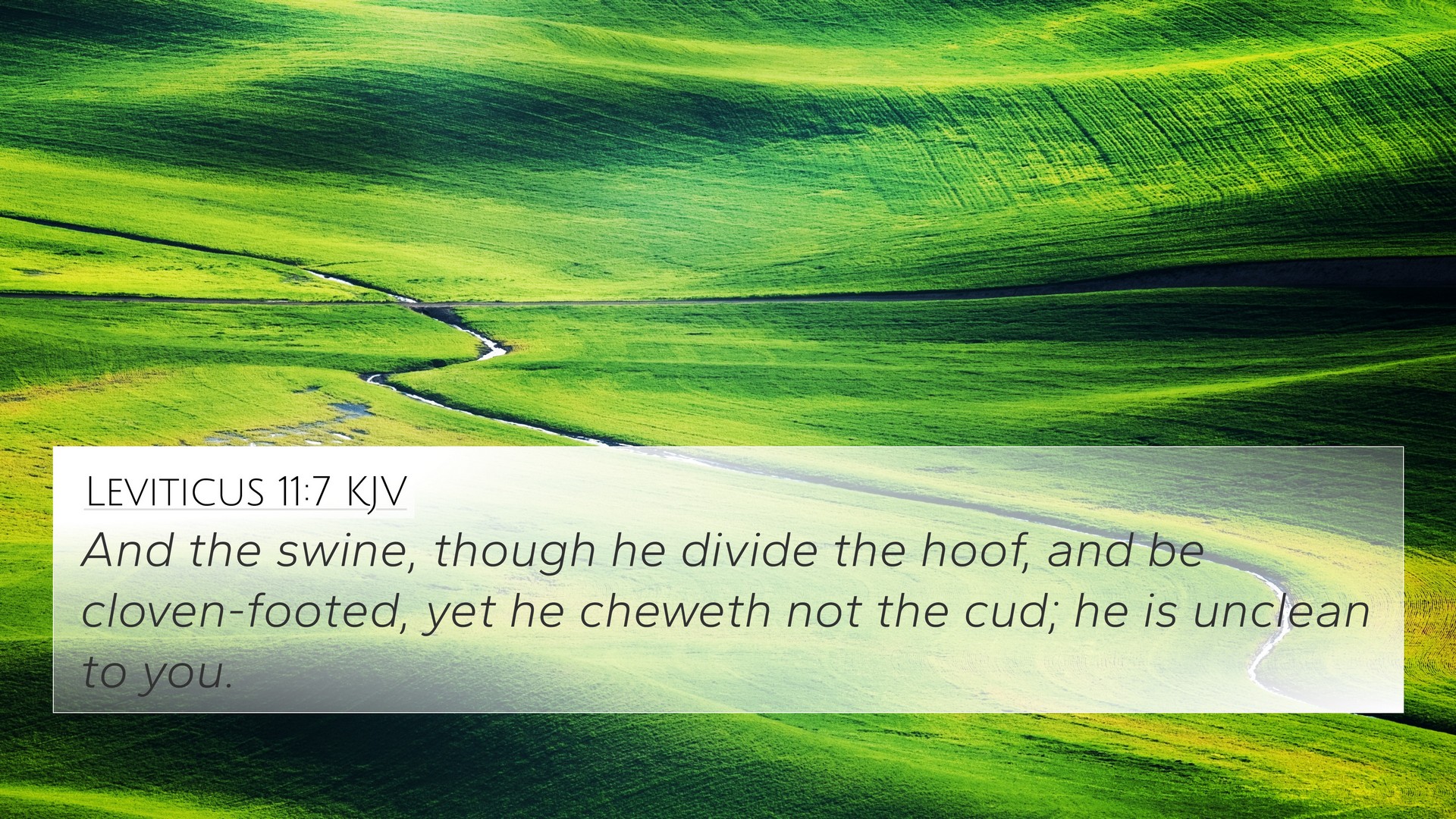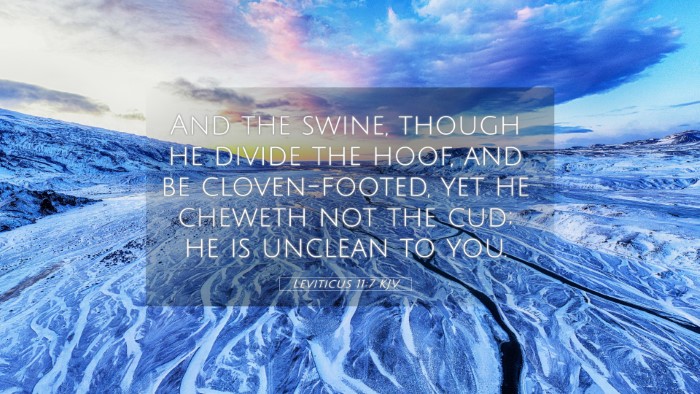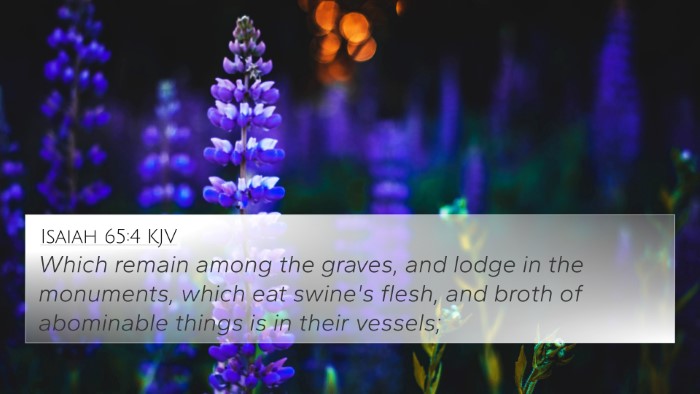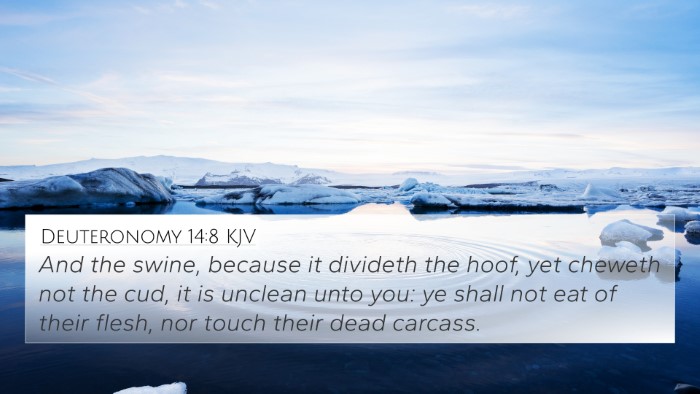Understanding Leviticus 11:7
Bible Verse: Leviticus 11:7 - "And the swine, though he divide the hoof, and be cloven-footed, yet he cheweth not the cud; he is unclean to you."
Interpretation and Meaning
This verse is part of the dietary laws that God established for the Israelites. The classification of animals as clean and unclean served both a physical and a spiritual purpose. Animals that chewed the cud and had divided hooves were considered clean and permissible for consumption, while those that did not meet these criteria were deemed unclean.
Key Insights from Public Domain Commentaries:
-
Matthew Henry:
Henry emphasizes that the distinction between clean and unclean animals reflects God's holiness and the importance of separation from impurity. The requirement for animals to both chew the cud and have split hooves symbolizes a deeper truth about living a life that aligns with God's commands.
-
Albert Barnes:
Barnes notes that swine, despite their outward appearance of being suitable (having a divided hoof), are fundamentally unclean because they do not chew the cud. This serves as a reminder that outer appearances can often be misleading, and true cleanliness before God involves an inner purity.
-
Adam Clarke:
Clarke provides historical context, explaining that the dietary laws were given to set the Israelites apart from other nations. The laws not only shaped the dietary practices of the Israelites but also taught them lessons about obedience, separation from sin, and holiness.
Thematic Connections
The theme of cleanliness and purity extends throughout the Bible, linking to various scriptures that echo similar sentiments regarding moral and spiritual purity. Below are several Bible cross-references related to Leviticus 11:7:
- Isaiah 66:17: Refers to the end of those who consume swine's flesh, highlighting the consequences of disobedience.
- Deuteronomy 14:8: Reiterates the prohibition of eating swine, reinforcing the dietary laws established by God.
- 2 Corinthians 6:17: Calls for spiritual cleanliness and separation from what is unclean, resonating with the message of Leviticus 11.
- Romans 14:14: Discusses the idea of purity and how some believers may consider certain foods clean or unclean.
- Matthew 15:11: Indicates that what enters the mouth does not defile a person, but rather what comes out of it reflects one’s true nature.
- 1 Peter 1:16: "Be ye holy; for I am holy," connects the concept of cleanliness to a broader call for holiness in the life of believers.
- Acts 10:15: A pivotal moment for Peter, indicating the new understanding of clean and unclean in the context of the Gospel.
Conclusion
Leviticus 11:7 may initially appear to be a simple dietary law, yet it speaks volumes about God's desire for His people to maintain spiritual cleanliness and separation from worldly influences. Understanding the various cross-references and the commentaries helps illuminate the significance of this verse within the larger narrative of Scripture.
Using Biblical Cross-Referencing Tools
For those interested in deeper study, utilizing tools for Bible cross-referencing, such as a Bible concordance or a cross-reference guide, can be very helpful in uncovering the connections between various scriptures. This approach aids in understanding the thematic Bible verse connections and enhances one’s overall comprehension of biblical teachings.
Explore More: Look for comparative Bible verse analysis and cross-referencing Bible study methods to enrich your understanding of how different scriptures relate to one another.
Resources for Bible Study
- Bible Concordances: Handy tools to locate and link Bible scriptures.
- Comprehensive Cross-Reference Materials: Useful for in-depth study of Bible verses that relate to each other.
- Cross-Reference Guides: Assist in identifying connections between the Old and New Testament.
Final Thoughts
In summary, Leviticus 11:7 not only instructs on dietary laws but serves as a reminder of the holiness that God expects from His followers. By examining the inter-biblical dialogue and understanding these connections through Bible verse parallels, believers can see the cohesion and depth of God's Word.










